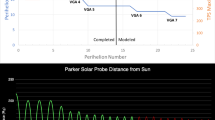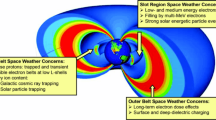Abstract
We derive calculated and experimental relations characterizing the reduction in the electric power of solar arrays under prolonged (∼10 years) action of the environment in orbit. The influence of separate factors related to the environment on the loss of solar arrays power is studied. The following factors are considered: ionizing and ultraviolet emissions, contamination of protective glass by the products of destruction of the outer surface materials of spacecraft, thermal cycling, radiation electrization, and plasma thrusters plumes.
Similar content being viewed by others
REFERENCES
Letin, V.A. Problems of Electrification of Spacecraft Solar Arrays, Kosmonavtika i Raketostroenie, 2003, no. 30, p. 42.
Model’ kosmicheskogo prostranstva (Model’ kosmosa-82) (A Model of Outer Space (Cosmos Model-82)), Vernov, S.N., Ed., Moscow: Mosk. Gos. Univ., 1983, vol. 2.
Shuvalov, V.A., Modelirovanie vzaimodeistviya tel s ionosferoi (Modeling of Interactions of Bodies with the Ionosphere), Kiev: Naukova Dumka, 1995.
Kreinin, L.B. and Grigor’eva, G.M., Solar Arrays under the Action of Space Radiation, Itogi Nauki Tekh., Ser.: Issled. Kosm. Prostr., Moscow: VINITI, 1979.
Raushenbakh, G., Spravochnik po proektirovaniyu solnechnykh batarei (Handbook on Design of Solar Arrays), Moscow: Energoatomizdat, 1983.
Garrett, H., The Geosynchronous Plasma Environment, Technol. Environment Spatial., Toulouse, 1987, p. 337.
Grigorieva, G.M., Kagan, M.B., Letin, V.A., et. al, Analysis of Geostationary Spacecraft Solar Arrays Degradation from Solar Proton Flares, Sixth European Space Power Conference, Porto, Portugal, 6–8 May, 2002 (ESA SP-502), p. 725.
Tribble, A.C., Revised Estimates of Photochemically Deposited Contamination on the GPS Satellites, J. Spacecraft and Rockets, 1998, vol. 35, no.1, p. 114.
Prisnyakov, V.F., On Degradation of Solar Arrays onboard Spacecraft, Kosmichna Nauka i Tekhnologiya, 1996, vol. 2, no.1/2, p. 73.
Dever, J.A., Bruckner, E.J., and Scheiman, D.A., et. al., Contamination of Space Environmental Effects on Solar Cells and Thermal Control Surfaces, J. Spacecraft and Rockets, 1995, vol. 32, no.5, p. 832.
Kulikov, I.A., Kuprii, A.A., Nichiporov, F.G., et al., Experimental Study of the Influence of Space Factors on Durability of Carbon Plastics, Fiz. Khim. Obrab. Mater., 1993, no. 1, p. 47.
Shuvalov, V.A., Determination of Integral Emissivity of Electrically Conducting Materials with the Help of Thermal Anemometric Probes, Teplofiz. Vys. Temp., 1984, vol. 22, no.3, p. 492.
Shuvalov, V.A., Priimak, A.I., and Gubin, V.V., Radiative Electrification of Spacecraft Construction Elements: Physical Modeling of Charge Accumulation and Neutralization, Kosm. Issled., 2001, vol. 39, no.1, pp. 18–26.
Letin, V.A., Optical, Radiation and Thermal Cycling Losses of Power Solar Array Returned from Orbital Station Mir after 10.5 years of Operation, Sixth European Space Power Conference, Porto, Portugal, 6–10 May, 2002 (ESA SP-502), p. 713.
Fudji, X., Shibuya, I., Abe, T., et al., Modeling of Processes of Electrification and Discharge of Electrically Insulating Covers of Satellites by Way of Irradiation of Their Surfaces with Electron Beams, Aerokosmich. Tekh., 1989, no. 5, p. 104.
Stevens, N.J., Barbay, G.J., et al., Modeling of Environmentally Induced Transients within Satellites, J. Spacecraft and Rockets, 1987, vol. 24, no.3, p. 259.
Akishin, A.I., Emission Processes at Electric Breakdown of Radiation-Charged Dielectrics, Fiz. Khim. Obrab. Mater., 1998, no. 5, p. 27.
Akishin, A.I., Tyutrin, Yu.I., and Tseplyaev, L.I., Electric Discharge Mechanism of Damage of Solar Arrays at Irradiation by Electrons, Fiz. Khim. Obrab. Mater., 1996, no. 6, p. 56.
Antonov, V.M. and Ponomarenko, A.G., Laboratornye issledovaniya effektov elektrizatsii kosmicheskikh apparatov (Laboratory Studies of Effects of Spacecraft Electrification), Novosibirsk: Nauka, 1992.
Parks, D.E. and Kats, I., Interaction of Plasma Generated by a Spacecraft with High-Voltage Solar Panels, Raketnaya Tekhnika i Kosmonavtika, 1980, vol. 18, no.1, p. 64.
Brosse, S., Electrical Effects of Plasma Propulsion on Geostationary Telecommunication Satellite, Alcatel Telecommunications Review, 2001, no. 4, p. 270.
Mandell, M.J., Katz, J., Steen, P.J., et al., The Effect of Solar Array Voltage Patterns Plasma Power Losses, IEEE Transactions on Nuclear Science, 1980, NS-27, no. 6, p. 1797.
Yagushkin, N.I., Grafodatskii, O.S., Islyaev, Sh.N., et al., Radiation and Electric Phenomena in Dielectric Materials of Spacecraft at Electrifications, in Issledovaniya po geomagnetizmu, aeronomii i fizike Solntsa (Investigations in Geomagnetism, Aeronomy, and Physics of the Sun), Moscow: Nauka, 1989, no. 86, p. 131.
Letin, V.A., Bordina, N.V., Zayavlin, V.R., et al., An Experimental Simulation of Space Environment Effects on the Solar-Cell Battery, Int. Conf. “Problems of Spacecraft-Environment Interaction” (Novosibirsk 1992), Irkutsk, 1992, p. 110.
Tarasov, V.N., Babkin, G.V., Morozov, E.P., et at., Electrostatic Behavior of Solar-Cell Batteries under Conditions of Radiation Electrization, Int. Conf. “Problems of Spacecraft-Environment Interaction” (Novosibirsk, 1992), Irkutsk, 1992, p. 58.
Askhabov, S.N., Burgasov, M.P., Veselovzorov, A.N., et al., Investigation of Jets of a Stationary Plasma Booster with Closed Drift of Electrons, Fiz. Plazmy, 1981, vol. 7, no.1, p. 225.
Grishin, S.D. and Leskov, L.V., Elektricheskie raketnye dvigateli kosmicheskikh apparatov (Electric Rocket Engines of Spacecraft), Moscow: Mashinostroenie, 1989.
Boyd, I.D., Review of Hall Thruster Plume Modelling, J. Spacecraft and Rockets, 2001, vol. 8, no.3, p. 381.
Olsen, R.K., Extreme Potentials of Charging Recorded during a Flight of the ATS-6 Satellite, Aerokosmich. Tekh., 1988, no. 5, p. 90.
Sputtering by Particle Bombardment, Behrische, R., Ed., Heidelberg: Springer, 1981, vol. 2.
Burgasov, M.P., Nadiradze, A.B., Chirov, A.A., et al., Effects of Interaction of Jets of Electric Rocket Engines with Solar Arrays of Spacecraft, Kosm. Issled., 1994, vol. 32, no.4/5, p. 194.
Korn, V.Z. and Shuvalov, V.A., Probe Diagnostics of a Flux of Particles Desorbed from the Surface of a Solid Body by a Jet of Rarefied Plasma, Prikladnaya Mekhanika i Tekhnicheskaya Fizika, 1993, vol. 34, no.5, p. 144.
Gatsonis, N.C., Eckman, R., Yin, X., et al., Experimental Investigations and Numerical Modeling of Pulsed Plasma Thruster Plumes, J. Spacecraft and Rockets, 2001, vol. 38, no.3, p. 454.
Shuvalov, V.A., Bystritskii, M.G., Kochubei, G.S., and Churilov, A.E., The Structure of Bunches and Jets of Pulsed Plasma Expanding into a Vacuum, Teplofiz. Vys. Temp., 2004, vol. 42, no.1, p. 23.
Danilin, B.S. and Kireev, I.Yu., Primenenie nizkotemperaturnoi plazmy dlya travleniya i ochistki materialov (Application of Low-Temperature Plasma for Etching and Cleaning of Materials), Moscow: Energoatomizdat, 1987.
Tajmar, M., Gonzalez, J., and Hilgers, A., Modeling of Spacecraft-Environment Interactions on SMART-1, J. Spacecraft and Rockets, 2001, vol. 38, no.3, p. 393.
Van Gilder, D.B., Boyd, J.D., and Keydar, M., Particle Simulations of a Hall Thruster Plume, J. Spacecraft and Rockets, 2001, vol. 37, no.1, p. 129.
Shuvalov, V.A., Kochubei, G.S., and Lazuchenkov, D.N., Structure of Exhaust Jets of Spacecraft Engines, Kosmichna Nauka i Tekhnologiya, 2003, vol. 9, no.4, p. 17.
Askhabov, S.N., Gdrlichko, D.P., Kozlov, A.I., et al., Investigation of the Effects of Jets and Thermal Emission of an Electrojet Engine on Solar Arrays of Spacecraft, Kosm. Issled., 1988, vol. 26, no.5, p. 796.
Chirov, A.A., Burgasov, M.P., Zayavlin, V.R., et al., Influence of Plasma Streams from an Ion-Plasma Jet Engine on Power-producing Features of Solar Arrays, Kosm. Issled., 1997, vol. 35, no.3, pp. 331–333.
Leet, S.J., Fogdall, L.B., and Wilkinson, M.C., Thermooptical Property Degradation of Irradiated Spacecraft Surfaces, J. Spacecraft and Rockets, 1995, vol. 32, no.5, p. 832.
Tribble, A.C. and Haffner, J.W., Estimates of Photochemically Deposited Contamination on the GPS Satellites, J. Spacecraft and Rockets, 1991, vol. 28, no.2, p. 222.
Neff, J., Mullen, K.R., and Fogdol, L.B., The Influence of Modeled Conditions in Synchronous Orbit on Characteristics of Contaminated Solar Reflector, Aerokosmich. Tekh., 1987, no. 8, p. 91.
Tribble, A.C., Boyadjian, B., Davis, J., et al., Contamination Control Engineering Design Guidelines for the Aerospace Community, NASA Contractor Report/NASA, 1996, no. 4740.
Ermolenko, A.F., Verification of Hypothesis of Linear Summation of Damages, Trudy Mosk. Energetich. Inst., 1974, no. 185, p. 52.
Pereverzev, E.S., Modeli nakopleniya povrezhdenii v zadachakh dolgovechnosti (Models of Accumulation of Failures in the Problems of Longevity), Kiev: Naukova Dumka, 1995.
Kulikov, I.A., Kuprii, A.A., and Yurlova, G.A., Experimental Studies of the Influence of Space Factors on Durability of Carbon Plastics, Fiz. Khim. Obrab. Mater., 1993, no. 4, p. 38.
Koltun, M.M., Solnechnye elementy (Solar Cells), Moscow: Nauka, 1987.
Author information
Authors and Affiliations
Additional information
__________
Translated from Kosmicheskie Issledovaniya, Vol. 43, No. 4, 2005, pp. 274–282.
Original Russian Text Copyright © 2005 by Shuvalov, Kochubei, Gubin, Tokmak.
Rights and permissions
About this article
Cite this article
Shuvalov, V.A., Kochubei, G.S., Gubin, V.V. et al. Power Losses of Solar Arrays under the Action of an Environment in a Geosynchronous Orbit. Cosmic Res 43, 259–267 (2005). https://doi.org/10.1007/s10604-005-0044-2
Received:
Issue Date:
DOI: https://doi.org/10.1007/s10604-005-0044-2




